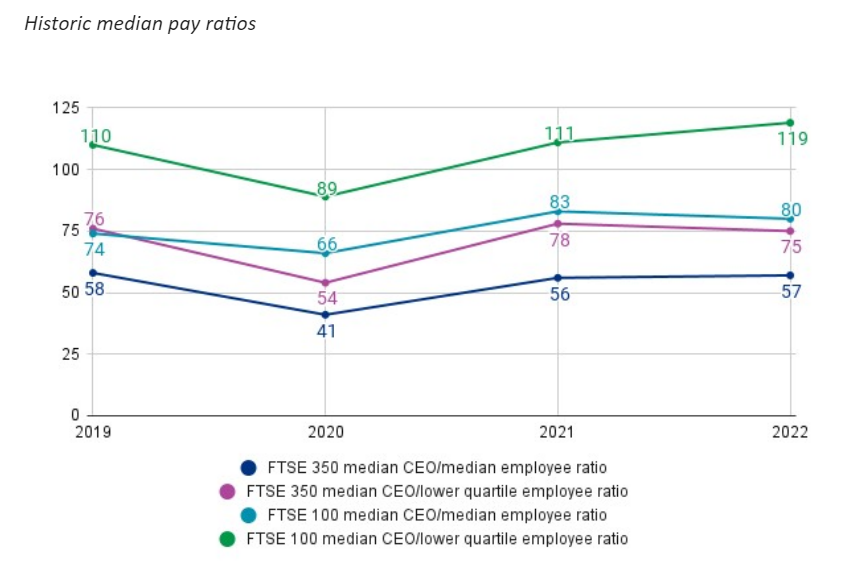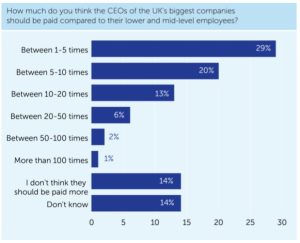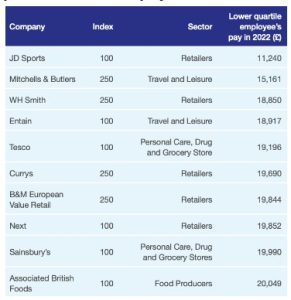Pay inequalities at UK’s largest companies remain constant, despite ‘cost of living’ crisis
- The median CEO/median employee pay ratio across the FTSE 350 was 57:1 in 2022, slightly up from 56:1 in 2021. 2022 saw a slight decrease in the median CEO/lower quartile (25th percentile) employee pay ratio for the FTSE 350, at 75:1 compared to 78:1 in 2021.
- In the FTSE 100, the median CEO/median employee ratio was 80:1 and the median CEO/lower quartile employee ratio was 119:1 (83:1 and 111:1 in 2021)
- In 2022, 21% of FTSE 350 companies had a CEO/median employee ratio of over 100:1, compared to 20% in 2021.
- The companies with lowest-paid UK employees (based on pay at the 25th percentile) were retailer JD Sports, where the lower quartile threshold was £11,240, pub chain Mitchells & Butlers (£15,161) and retailer WH Smiths (£18,850)

New research published today by the High Pay Centre think tank, funded by the abrdn Financial Fairness Trust, shows that CEO to employee pay gaps at Britain’s biggest companies remained stable in 2022 after narrowing during the Covid pandemic and then widening again in 2021. The median CEO/median employee pay ratio across the FTSE 350 was 57:1 in 2022, slightly up from 56:1 in 2021. The median gap between CEOs and their lowest-paid quarter of employees fell slightly in 2022 to 75:1 from 78:1 in 2021. Across the larger FTSE 100 companies, the gaps were wider, with a median CEO/median employee pay ratio of 80:1 and a median CEO/lower quarter employee of 118:1.
Over a fifth of FTSE 350 companies (21%) had a CEO to median employee pay ratio of over 100:1 and 3% had a ratio of over 200:1. In addition, 35% had a CEO to lower quarter employee ratio of over 100:1 and 7% over 200:1. The ratio reporting requirements exclude lowest-paid workers but the High Pay Centre estimates (based on living wage accreditation) that the median CEO to lowest paid worker (as opposed to employee) across the FTSE 350 would be around 165:1. Previous High Pay Centre research found that 76% of people think top earners should not be paid more than 20 times their low and middle earning colleagues, while just 3% thought that it was right for CEOs to make more than low and middle earners.

The report argues that while the pay ratio disclosures have major limitations and imperfections that ought to be addressed, they have filled a gap in corporate reporting. Even though annual reports are typically now over 200 pages long and remuneration reports average 29 pages in length, the pay ratios are the only reporting requirements that provide investors, workers and other stakeholders with consistent, comparable data on pay levels of workers outside the boardroom.
The report recommends that:
- Companies should provide more detailed information on how many jobs they provide at different pay levels.
- Outsourced workers, who often carry out very low-paid work, should be included in the pay ratio calculations.
- Companies should be required to communicate information on CEO to worker pay gaps directly to their workforce, as well as publishing the figures in their annual report.
The High Pay Centre’s view is that we need a fairer, more equal, more inclusive economy where companies create lots of well-paid jobs for all their workers, rather than a handful of obscenely paid roles for those at the top.
The pay ratio trends highlight a moment of solidarity during the pandemic when CEO to employee pay gaps narrowed, but that seems to have been lost as gaps have widened to pre-pandemic levels over the subsequent two years.
Widest CEO to employee pay ratios, 2022 (employees=UK employee at 25th percentile of the pay distribution on a full-time-equivalent basis)

Companies with lowest-paid employees, 2022 (employees=UK employee at 25th percentile of the pay distribution on a full-time-equivalent basis)

The research has been covered widely in the media including by the Financial Times, the Guardian, the Times, the Telegraph, the Independent and City AM.